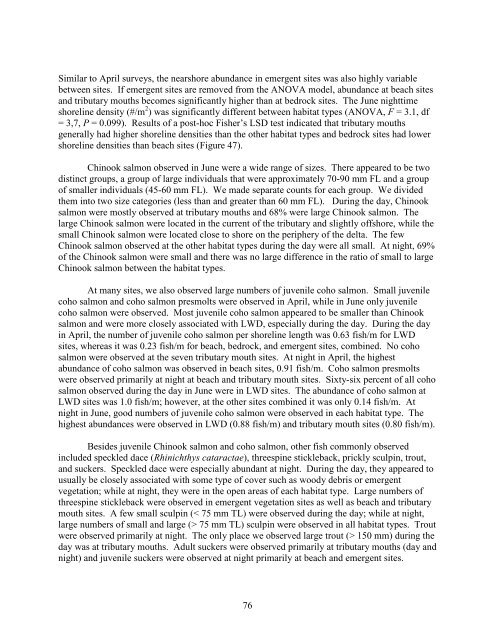Nearshore Habitat Use by Juvenile Chinook Salmon in Lentic ...
Nearshore Habitat Use by Juvenile Chinook Salmon in Lentic ...
Nearshore Habitat Use by Juvenile Chinook Salmon in Lentic ...
You also want an ePaper? Increase the reach of your titles
YUMPU automatically turns print PDFs into web optimized ePapers that Google loves.
Similar to April surveys, the nearshore abundance <strong>in</strong> emergent sites was also highly variable<br />
between sites. If emergent sites are removed from the ANOVA model, abundance at beach sites<br />
and tributary mouths becomes significantly higher than at bedrock sites. The June nighttime<br />
shorel<strong>in</strong>e density (#/m 2 ) was significantly different between habitat types (ANOVA, F = 3.1, df<br />
= 3,7, P = 0.099). Results of a post-hoc Fisher’s LSD test <strong>in</strong>dicated that tributary mouths<br />
generally had higher shorel<strong>in</strong>e densities than the other habitat types and bedrock sites had lower<br />
shorel<strong>in</strong>e densities than beach sites (Figure 47).<br />
<strong>Ch<strong>in</strong>ook</strong> salmon observed <strong>in</strong> June were a wide range of sizes. There appeared to be two<br />
dist<strong>in</strong>ct groups, a group of large <strong>in</strong>dividuals that were approximately 70-90 mm FL and a group<br />
of smaller <strong>in</strong>dividuals (45-60 mm FL). We made separate counts for each group. We divided<br />
them <strong>in</strong>to two size categories (less than and greater than 60 mm FL). Dur<strong>in</strong>g the day, <strong>Ch<strong>in</strong>ook</strong><br />
salmon were mostly observed at tributary mouths and 68% were large <strong>Ch<strong>in</strong>ook</strong> salmon. The<br />
large <strong>Ch<strong>in</strong>ook</strong> salmon were located <strong>in</strong> the current of the tributary and slightly offshore, while the<br />
small <strong>Ch<strong>in</strong>ook</strong> salmon were located close to shore on the periphery of the delta. The few<br />
<strong>Ch<strong>in</strong>ook</strong> salmon observed at the other habitat types dur<strong>in</strong>g the day were all small. At night, 69%<br />
of the <strong>Ch<strong>in</strong>ook</strong> salmon were small and there was no large difference <strong>in</strong> the ratio of small to large<br />
<strong>Ch<strong>in</strong>ook</strong> salmon between the habitat types.<br />
At many sites, we also observed large numbers of juvenile coho salmon. Small juvenile<br />
coho salmon and coho salmon presmolts were observed <strong>in</strong> April, while <strong>in</strong> June only juvenile<br />
coho salmon were observed. Most juvenile coho salmon appeared to be smaller than <strong>Ch<strong>in</strong>ook</strong><br />
salmon and were more closely associated with LWD, especially dur<strong>in</strong>g the day. Dur<strong>in</strong>g the day<br />
<strong>in</strong> April, the number of juvenile coho salmon per shorel<strong>in</strong>e length was 0.63 fish/m for LWD<br />
sites, whereas it was 0.23 fish/m for beach, bedrock, and emergent sites, comb<strong>in</strong>ed. No coho<br />
salmon were observed at the seven tributary mouth sites. At night <strong>in</strong> April, the highest<br />
abundance of coho salmon was observed <strong>in</strong> beach sites, 0.91 fish/m. Coho salmon presmolts<br />
were observed primarily at night at beach and tributary mouth sites. Sixty-six percent of all coho<br />
salmon observed dur<strong>in</strong>g the day <strong>in</strong> June were <strong>in</strong> LWD sites. The abundance of coho salmon at<br />
LWD sites was 1.0 fish/m; however, at the other sites comb<strong>in</strong>ed it was only 0.14 fish/m. At<br />
night <strong>in</strong> June, good numbers of juvenile coho salmon were observed <strong>in</strong> each habitat type. The<br />
highest abundances were observed <strong>in</strong> LWD (0.88 fish/m) and tributary mouth sites (0.80 fish/m).<br />
Besides juvenile <strong>Ch<strong>in</strong>ook</strong> salmon and coho salmon, other fish commonly observed<br />
<strong>in</strong>cluded speckled dace (Rh<strong>in</strong>ichthys cataractae), threesp<strong>in</strong>e stickleback, prickly sculp<strong>in</strong>, trout,<br />
and suckers. Speckled dace were especially abundant at night. Dur<strong>in</strong>g the day, they appeared to<br />
usually be closely associated with some type of cover such as woody debris or emergent<br />
vegetation; while at night, they were <strong>in</strong> the open areas of each habitat type. Large numbers of<br />
threesp<strong>in</strong>e stickleback were observed <strong>in</strong> emergent vegetation sites as well as beach and tributary<br />
mouth sites. A few small sculp<strong>in</strong> (< 75 mm TL) were observed dur<strong>in</strong>g the day; while at night,<br />
large numbers of small and large (> 75 mm TL) sculp<strong>in</strong> were observed <strong>in</strong> all habitat types. Trout<br />
were observed primarily at night. The only place we observed large trout (> 150 mm) dur<strong>in</strong>g the<br />
day was at tributary mouths. Adult suckers were observed primarily at tributary mouths (day and<br />
night) and juvenile suckers were observed at night primarily at beach and emergent sites.<br />
76
















